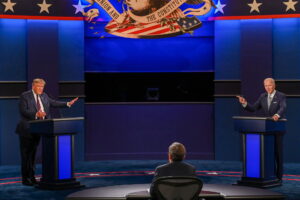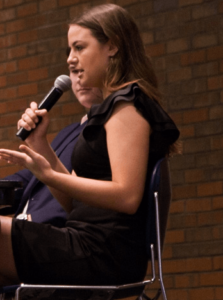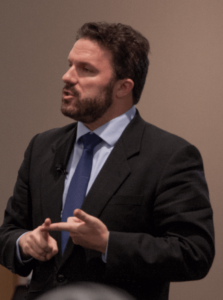Tag: debate
Bursting the PC Bubble: Takeaways from the First 2020 Presidential Debate
by The Cowl Editor on October 15, 2020
National and Global News

by Addison Wakelin ’22
News Staff
Less than a month away from the 2020 presidential election, the first presidential debate left many Americans in a state of pessimism and uncertainty about the future of the United States.
On Tuesday, Sept. 29 in Cleveland, former Vice President Joe Biden and President Donald Trump faced off in a brutish debate during one of the most unprecedented times in modern U.S. history. The debate was moderated by Fox News anchor Chris Wallace.
Although the debate became somewhat personal given Trump’s jeers and ad hominem attacks against Biden and his family—especially Hunter Biden—the two debated on some important topics pertaining to the United States. The debate can be broken down into several important topics, picked by Wallace, including the Supreme Court vacancy, the COVID-19 pandemic, protests and violence in cities as a result of the issue of racism, and the economy.
Following the tragic death of former Supreme Court Justice Ruth Bader Ginsburg, the Supreme Court vacancy has become a point of interest for Republicans. Less than two weeks after RBG’s death, Trump announced he would nominate Amy Coney Barrett to the Supreme Court.
Several Republicans, including South Carolina Senator Lindsey Graham and Kentucky Senator Mitch McConnell, have been criticized for their hypocritical comments on blocking Obama’s nomination of Merrick Garland to the Supreme Court in 2016, claiming it would be unfair to Americans to vote for a justice during an election year.
Biden countered Trump’s claims, warning that Barrett’s potentially successful nomination will solidify a 6-3 conservative majority in the Supreme Court. As a result, Republicans will be able to repeal Roe v. Wade and the Affordable Care Act, unraveling years of progressive lawmaking that could strip away healthcare accessibility and benefits for many Americans, especially women.
COVID-19 also became a major point of discussion during the debate. Trump has been criticized for holding several rallies without masks or social distancing enforcement, as the U.S. has surpassed 215 thousand coronavirus deaths. Trump taunted Biden during the debate for his mask-wearing, saying, “I don’t wear a mask like him. Every time you see him, he’s got a mask. He could be speaking 200 feet away from you and he shows up with the biggest mask I’ve ever seen.”
Less than 72 hours after the debate, on Oct. 2, Trump announced he tested positive for COVID-19. He tweeted: “Tonight, @FLOTUS and I tested positive for COVID-19.” Trump was promptly hospitalized at Walter Reed Hospital and treated with an experimental antibody treatment, steroids, and oxygen. He has since been released.
Perhaps the most shocking part of the debate was Trump’s failure to condemn white supremacists. Wallace challenged Trump, asking if he is willing to “condemn white supremacists and militia groups.” Both Wallace and Biden pushed Trump to condemn white supremacists. After asking for a specific group to condemn, Biden suggested the Proud Boys, a far-right, fascist organization that spouts anti-Semitic, Islamophobic and other bigoted rhetoric.
Trump stated, “Proud Boys, stand back and stand by.” Trump’s comments caused an uproar. “Stand back and stand by” suggests that these groups wait for his command and is not a condemnation of their actions.
The debate left one question: who won? For many Americans, the answer is no one. The nation is at a standstill between polarizing political beliefs and a chaotic year defined by a pandemic and socio-racial upheaval.
Many viewers felt as though the true loser of the debate was the United States itself. Between the U.S. nearing almost 220 thousand coronavirus deaths, millions of Americans having filed for unemployment and facing eviction since the pandemic started, and growing social unrest, the U.S. faces a desolate political landscape.
Only time will tell if the U.S. can muster the strength and unity necessary to overcome the hardships that have plagued this country.
After Trump’s COVID-19 diagnosis, the Commission on Presidential Debates decided that the second presidential debate, initially scheduled for Oct. 15, would be canceled, citing Trump’s refusal to participate in a virtual debate.
Both candidates have instead opted to host their own respective virtual town halls on Oct. 15 at 8 p.m., with NBC covering Trump’s town hall and ABC covering Biden.
The next debate is scheduled for Thursday, Oct. 22 in Nashville, moderated by NBC’s White House correspondent Kristen Welker.
To Bear or Not to Bear: PC Democrats and Republicans Square Off in Gun Control Debate
by The Cowl Editor on April 4, 2019
Campus

By Alexandra Huzyk ’20
News Staff
On Wednesday, March 27, Providence College Democrats and Republicans held a debate on gun control.
Madison Clark ’19 and Bryan Bates ’20 represented the PC Democrats, while Krista Minniti ’20 and Charlie Dumon ’21 represented the PC Republicans. Dr. Joe Cammarano, a professor of public and community service and political science at the College, acted as the moderator and enforced the structural components of the debate.
The first question that was posed was: “Will gun regulations make a community safer?”
The PC Democrats began with their argument, asserting that statistics have proven that communities with higher levels of gun ownership have higher levels of gun violence per capita.
Clark argued that through the creation of gun regulations, imposing consistent background checks, and restricting open-carry laws, a community would become safer. Bates added to this argument, stating,“Some people say cars are more dangerous than guns. Instead of outlawing them, we regulated them to make sure they are safer for society as a whole.”
In response, PC Republicans argued that gun regulations would not make a community safer.
Minniti argued that a large percentage of reported gun violence was attributed to suicide and illegally owned handguns, which would be attained through the black market no matter the amount of regulations imposed. She used Canada as an example of a country with higher gun rates per capita and lower homicide rates than the U.S. to further emphasize her point that regulations are not the answer to making a community safer.
Dumon took a more radical approach in his contribution, citing the Sutherland Springs Church shooting in 2017. He claimed that, “Deregulations are something that will make the community safer.” Dumon stated that the only thing that ended the massacre was a “good guy with a gun.”
Each side was given one minute to offer a rebuttal to the opposing side’s argument. The Democratic side chose to approach the point brought up in regards to suicide.
Clark stated, “Over two-thirds of deaths related to guns are also related to suicide.” People who choose to use guns for a method of suicide are more likely to actually die, as opposed to those who choose to use pain killers or other methods. Clark concluded that, “reducing the availability of guns has an impact on whether or not a person actually dies.”
The Republican members refocused on the homicide rates, claiming that creating further gun regulations would only cause more people to access the black market. They cited Chicago as a city that has some of the strictest regulations on guns in the country, and yet has a very high homicide rate.
The second pre-determined question that Dr. Cammarano posed was: “How should schools prepare for active shooters?”
The Republicans initiated the debate, beginning with the assertion that schools should have at least one armed officer and there should be training for teachers on how to use a firearem.
Dumon argued that it would be more efficient and beneficial for a teacher to have a gun in order to minimize carnage. He emphasized the amount of time it would take to respond to a shooter without having a gun, by counting the seconds it would take to walk to the fire exit, attempt to get the fire extinguisher, and successfully disable the shooter.
The Democrats argued that instead of giving teachers guns, people should be confronting the motivations and underlying causes of why individuals commit school shootings. Instead of arming staff on school grounds, Clark argued that there should be resources provided to educate teachers on how to resolve conflict without violence.
Clark also asserted that the presence of an armed officer might add to existing tensions, particularly in racially diverse schools. Bates added, “resource officers can be a good asset,” if they are guided on how to use their expertise within schools specifically.
Another question was: “How should the Second Amendment be understood?”
Minniti began the argument for the Republican side by stating that it should be interpreted in the most literal sense. She claimed, “Without the Second Amendment, there is nothing that stands between citizens and anarchy,” for it was initially created for defense against totalitarianism. Tyranny, Minniti asserted, is not a thing of the past.
Dumon elaborated on this tangent, stating, “The Second Amendment was the greatest gift that God ever imposed on the USA,” because it protects all other protections. He cited tyrannical leaders such as Adolf Hitler, Joseph Stalin, Vladimir Lenin, and Mao Zedong who took away peoples’ guns and thus took away their fundamental ability to defend themselves against their government.
Bates began the Democratic argument by stating that the Second Amendment and the Constitution itself “is a living and breathing document.” He argued that if people fail to interpret it in a modern context, we won’t be able to progress as a society. Bates stated that the Amendment was “predicated on the idea of a well-regulated militia,” which they defined as state force.
Both Bates and Clark argued that the Amendment was built to be flexible and to fit the modern age.
Other questions involved how each side defined self-defense, if there should be a universal background check, and if there should be any factors that disqualify someone from the right to bear arms.
Followed by the discussion of these predetermined questions was the opportunity for the audience to submit questions for the panel.
These questions addressed critical topics such as how one can objectively know whether or not a guy with a gun is “good,” whether a teacher should be obligated to use a gun on a student who has a weapon, stand-your-ground laws, and how realistic it is to argue that the Second Amendment protects the right to defend against tyranny when weapons of mass destruction exist.
This debate provided a unique opportunity for PC students to voice their opinions about a divise topic in a civil and engaging manner.
What Can Money Really Buy? : Professors Debate on the Morality of the Marketplace
by The Cowl Editor on October 25, 2018
Campus
by Micaela Freeman ’20
Campus Ministry, Providence College School of Business, and the Center for Catholic and Dominican Studies hosted a sparked debate on Thursday in the Arthur F. and Patricia Ryan Center for Business Studies between two university professors.
The debate, titled “There are some things that money should not buy,” brought in PC’s associate professor of philosophy Dr. Colin King and Georgetown University’s Dr. Jason Brennan.
The debate was centered around the idea of whether or not money can truly buy happiness. King and Brennan went head to head speaking about the value of life and how money can better it through a parliamentary style debate. Dr. King, who flew to Providence from Switzerland, argued that money should not be able to buy everything due to the fundamentals of ethics.
Dr. King brought up points such as grades and voting fraud; money should not buy a vote, and should not buy an A despite the student’s work saying otherwise.
Dr. Brennan argued for the negative, and discussed that if there is somethingyou would not do for free, you should not be able to pay for it. If you would do something, however, people should have the option to pay for it. Brennan also brought up points such as prostitution being bad, yet people pay for it; however, paying for a child was justified in the debate because of the establishment of adoption.
The event allowed students to see how debate skills can be applied to a professional debate and how specific skills, such as warranting arguments and weighing the importance of the argument, can help in everyday life.
Many of the members of Providence College Debate Society were very eager to listen in on a professional debate.
Noah DeRossi-Goldberg ’22, said the debate was both enjoyable as well as educational, “It was very philosophical. It was really good.”
As a political science major, DeRossi-Goldberg appreciated seeing the application of politics and how a debate works in the real world.
“It gave me great lessons on how to improve my debating skills,” DeRossi-Goldberg added.
Carly Martino ‘19 also attended the debate and enjoyed it as well. Martino is the acting co-president of the Debate Society and said she was thrilled to see fellow members in attendance.
Martino emphasized that she felt she learned a lot, saying, “I found it really interesting, even if I got lost in the economics sometimes. But the questions that they broke down were extremely [enlightening].”
Martino said the entire debate was especially interesting, and she enjoyed the structure and the points of the debate.
“The most interesting part was the end when they took questions from the audience, and new points were brought up,” Martino said.
The event received praise, and many members of the audience and the debate team said they would love another professional style debate.

